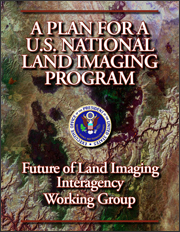 The Bush Administration today announced the release of a plan for a U.S. National Land Imaging Program. The plan will serve as the framework for continuing the collection of moderate resolution multispectral remote sensing data for the globe. The new Program would be established at the Department of the Interior and would provide focused leadership and management for the nation’s land imaging efforts. “This plan reflects President Bush’s commitment to play a leadership role in understanding the changes in the land surface we observe across the world,” said John H. Marburger, Science Advisor to the President and Director of the Office of Science and Technology Policy. “The land surface, polar regions, and coastal zones are undergoing significant changes under the pressures of population growth, development, and climate change, and we must carefully monitor these changes in order to manage them. The importance of this imagery to the Nation requires a more sustainable effort to ensure that land imaging data are available far into the future.”
The Bush Administration today announced the release of a plan for a U.S. National Land Imaging Program. The plan will serve as the framework for continuing the collection of moderate resolution multispectral remote sensing data for the globe. The new Program would be established at the Department of the Interior and would provide focused leadership and management for the nation’s land imaging efforts. “This plan reflects President Bush’s commitment to play a leadership role in understanding the changes in the land surface we observe across the world,” said John H. Marburger, Science Advisor to the President and Director of the Office of Science and Technology Policy. “The land surface, polar regions, and coastal zones are undergoing significant changes under the pressures of population growth, development, and climate change, and we must carefully monitor these changes in order to manage them. The importance of this imagery to the Nation requires a more sustainable effort to ensure that land imaging data are available far into the future.”
The report presents a set of policy recommendations to achieve a stable and sustainable U.S. operational space-based land imaging capability and to ensure continued U.S. scientific, technological, and policy leadership in civil land imaging and the scientific disciplines it supports. The Plan calls for continued U.S. commitment to moderate-resolution land imagery, recommends the United States maintain a core operational capability for land imagery while supplementing its data with similar data from partners, and designates the Department of the Interior as the host of the program.
The U.S. Landsat series of satellites has provided imagery of the entire Earth’s surface on a seasonal basis since it was begun in 1972. The data from Landsat are used for a wide variety of applications of land surface changes in land-use planning, agriculture, disaster reduction, water management, and analysis of human development. Currently, Landsat 5 and Landsat 7 are actively collecting data but are near the end of their functional lives. A successor to these satellites, the Landsat Data Continuity Mission, is scheduled to be launched in 2011. The creation of the National Land Imaging Program will ensure the availability of these key data far into the future.
The new plan for a National Land Imaging Program will provide a mechanism within the Interior Department to assess the land imagery needs of federal agencies, state and local land management officials, scientists, and geographic researchers, and to translate those needs into the technical capabilities of future satellites. Responsibility for development, launch, and management of the long series of Landsat satellites has historically moved among agencies, and establishing the National Land Imaging Program will ensure a consistent planning and budgeting process for future land imaging missions.
The plan was developed by the Future of Land Imaging Interagency Working Group (FLIIWG), an ad hoc group convened under the National Science and Technology Council, Committee on Environment and Natural Resources. The FLIIWG was comprised of fifteen agencies from seven Executive Branch departments. The work of the FLIIWG was conducted under the auspices of the U.S. Group on Earth Observations.
For further information, visit:
+ Office of Science and Technology Policy website
+ Future of Land Imaging website

Be Part of What’s Next: Emerging Applications of Landsat at AGU24
Anyone making innovative use of Landsat data to meet societal needs today and during coming decades is encouraged to submit and abstract for the upcoming “Emerging Science Applications of Landsat” session at AGU24.





